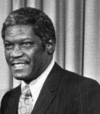 During segregation, Black high-school head coaches were more than athletic leaders—they were cultural anchors and guardians of their communities. Working with scarce resources, they built programs that instilled discipline, pride, and resilience in young men and women. Their influence often extended far beyond sports, shaping how entire communities carried themselves in a society built on inequality.
During segregation, Black high-school head coaches were more than athletic leaders—they were cultural anchors and guardians of their communities. Working with scarce resources, they built programs that instilled discipline, pride, and resilience in young men and women. Their influence often extended far beyond sports, shaping how entire communities carried themselves in a society built on inequality.
A powerful example is James ” Big Jim” Williams, the legendary football coach at Blake High School in Tampa, Florida. Known for his commanding presence and deep respect among young men, Williams was more than a coach—he was a stabilizing force. After the assassination of Dr. Martin Luther King Jr. in 1968, when anger spilled into the streets, Williams is credited with quelling potential riots. His word carried weight because his players—and the wider community—trusted him. That kind of authority, rooted in lived experience and mentorship, could not be duplicated by white coaches brought in after integration.
When desegregation arrived, Black athletes gained opportunities to play in better-funded schools and leagues, but many Black coaches were replaced by white counterparts. These substitutions proved inadequate. White coaches often lacked the cultural understanding to mentor young Black athletes through the daily realities of racism. They were not embedded in the community in the same way, and they could not model Black leadership in a world that denied it. The loss was not just professional but deeply communal.
Yet the legacy of men like Big Jim Williams endures. Their work demonstrates that sports were never just about winning games—they were about preparing young people to meet life’s challenges with discipline and dignity. Today, as debates about representation in coaching continue, their example reminds us that leadership rooted in cultural pride and community connection is irreplaceable.